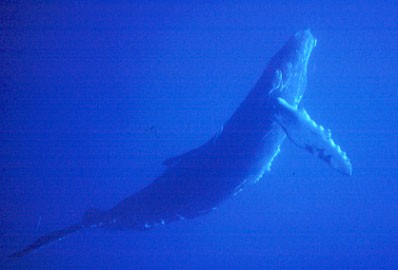Acoustics is a critical field of study for whale researchers, and the songs of humpback whales stand out as some of the most complex vocalizations in the animal kingdom. These intricate songs provide invaluable information across various areas of marine research and technology. The humpback song, characterized by repeating themes, can extend up to 30 minutes, with some whales singing continuously for hours. Interestingly, only male humpbacks sing, and within a specific region, all males sing the same song, which evolves over time, differentiating itself from year to year. These songs are predominantly observed during the breeding season, suggesting a connection to reproduction. However, the fundamental question of why male humpbacks sing continues to intrigue researchers.
 Humpback whale breaching the surface of the ocean.
Humpback whale breaching the surface of the ocean.
The Importance of Hearing for Whales
Beyond singing, humpback whales possess excellent hearing capabilities. Sound is of paramount importance to marine mammals, especially given the noisy underwater environment. Among cetaceans, hearing is highly developed, relying on the sensitive reception of waterborne vibrations through bones in the head. The size of a whale’s head, often comprising up to one-third of its total body length, underscores this adaptation. The whale ear, a small opening that closes underwater, features a bone structure in the middle and inner ears modified from terrestrial mammals to facilitate underwater hearing.
Deconstructing Whale Songs: Frequency and Range
Humpback whales generate a variety of sounds, including moans, grunts, blasts, and shrieks. Each component of their song consists of sound waves. Some of these sound waves are high frequency, which, if visible, would appear as tall, pointed mountains. Conversely, whales also produce low-frequency sound waves, resembling wide, spread-apart hills. These low-frequency sounds can travel vast distances in water with minimal energy loss. Researchers propose that certain low-frequency sounds can propagate over 10,000 miles in specific layers of the ocean.
Sound frequencies are measured in Hertz (Hz). Whales utilize a frequency range from approximately 30 Hz to 8,000 Hz (8 kHz). Humans can only perceive a portion of the whale’s song because we cannot detect the lowest frequencies, typically hearing sounds starting at around 100 Hz. This difference in hearing range limits our ability to fully appreciate the complexity and potential range of whale vocalizations.
Similarities to Other Animal Sounds
Interestingly, researchers have noted similarities between whale songs and the vocalizations of hoofed animals, such as elk (bugling) and cattle (mooing), with resemblances also observed in some elephant sounds. Katy Payne, a leading researcher in humpback whale sounds, also studies elephant vocalizations and has identified parallels between the two species. This suggests that the mechanisms and purposes behind sound production may share common evolutionary roots across different animal groups.
Sound Production in Whales: A Complex System
Initially, the larynx was believed to be the primary site of sound production in cetaceans. However, experiments on live, vocalizing dolphins revealed that the larynx does not move during vocalizations. Instead, structures within the nasal system, including the nasal plug and the complex nasal sac system, move when sound is produced. While the exact mechanism of sound generation remains under debate, the nasal system is now considered crucial. Further information on this fascinating topic can be found in the book Biology of Marine Mammals by Reynolds and Rommel.
Exploring the Range: How Far Does a Whale Song Travel?
The remarkable ability of low-frequency whale songs to travel up to 10,000 miles underscores the importance of sound in whale communication and navigation. These vast distances enable whales to communicate across entire ocean basins, potentially facilitating mating, coordinating migrations, and sharing information about food sources or threats. The study of how far a whale song travels is vital to understanding whale behavior and protecting these magnificent creatures in an increasingly noisy ocean environment.